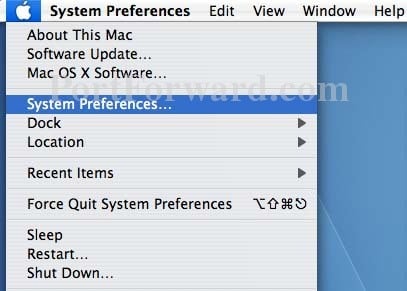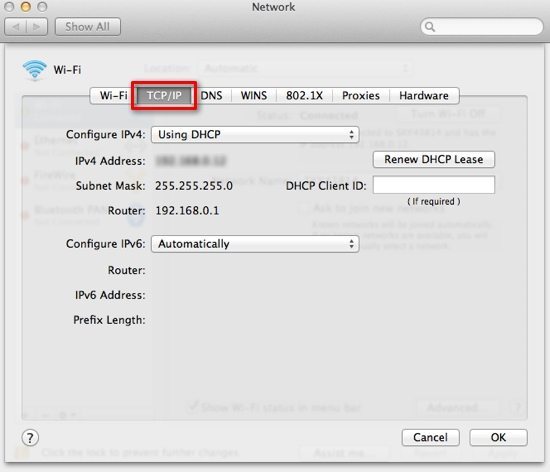Ipconfig in Mac OS X serves as a wrapper to the IPConfiguration agent, and can be used to control the Bootstrap Protocol and DHCP client from the command-line interface. Like most Unix-based operating systems, Mac OS X also uses ifconfig for more direct control over network interfaces, such as configuring static IP addresses.
| Developer(s) | Microsoft, ReactOS Contributors, Apple Inc. |
|---|---|
| Operating system | Microsoft Windows, ReactOS, macOS |
| Type | Command |
| License | Microsoft Windows: Proprietarycommercial software ReactOS: GNU General Public License |
In computing, ipconfig (internet protocolconfiguration) is a console application of some operating systems that displays all current TCP/IP network configuration values and refresh Dynamic Host Configuration Protocol (DHCP) and Domain Name System (DNS) settings.[1]
Manual configuration of an IP address Instead of letting the computer obtain its IP address from the router via DHCP you can choose to manually configure the IP settings on the computer. Normally this is avoided since it can cause a few different problems unless it is handled properly by the administrator, which is you. How to Set a Manual IP Address in Mac OS X Launch ‘System Preferences’ from the Apple menu (or Spotlight). Click on the 'Network' icon. In the lower right, click on the ‘Advanced’ button. In the pulldown menu next to 'Configure IPv4' select 'Manually' (or DHCP with manual address.
Mac Manual Ip Config Server
- 1Implementations
Implementations[edit]
The command is available in MicrosoftWindows, ReactOS, and in ApplemacOS. The ReactOS version was developed by Ged Murphy and is licensed under the GPL.[2]
Microsoft Windows, ReactOS[edit]
The ipconfig command supports the command-line switch/all. This results in more detailed information than ipconfig alone.
An important additional feature of ipconfig is to force refreshing of the DHCP IP address of the host computer to request a different IP address. This is done using two commands in sequence. First, ipconfig /release is executed to force the client to immediately give up its lease by sending the server a DHCP release notification which updates the server's status information and marks the old client's IP address as 'available'. Then, the command ipconfig /renew is executed to request a new IP address.[3][4] Where a computer is connected to a cable or DSL modem, it may have to be plugged directly into the modem network port to bypass the router, before using ipconfig /release and turning off the power for a period of time, to ensure that the old IP address is taken by another computer.[5]
The /flushdns parameter can be used to clear the Domain Name System (DNS) cache to ensure future requests use fresh DNS information by forcing hostnames to be resolved again from scratch.[6]
Apple macOS[edit]
ipconfig in Mac OS X serves as a wrapper to the IPConfiguration agent, and can be used to control the Bootstrap Protocol and DHCP client from the command-line interface.[7] Like most Unix-based operating systems, Mac OS X also uses ifconfig for more direct control over network interfaces, such as configuring static IP addresses.
See also[edit]

References[edit]
- ^Microsoft Windows XP ipconfig support page
- ^https://github.com/reactos/reactos/blob/master/base/applications/network/ipconfig/ipconfig.c
- ^Release and Renew Your IP Address
- ^Windows – Displaying, Releasing and Renewing a DHCP Lease
- ^whatsmyipaddress: How to change your IP address
- ^Windows 8.1 PCs Connect to the Network but not the Internet
- ^OS X developer manual
Further reading[edit]

- Frisch, Æleen (2001). Windows 2000 Commands Pocket Reference. O'Reilly. ISBN978-0-596-00148-3.
- Stanek, William R. (2008). Windows Command-Line Administrator's Pocket Consultant, 2nd Edition. Microsoft Press. ISBN978-0735622623.
- Barrett, Daniel J. (2012). Macintosh Terminal Pocket Guide: Take Command of Your Mac. O'Reilly. ISBN978-1449328986.
External links[edit]
| Wikibooks has a book on the topic of: Guide to Windows Commands |
- Windows
- Mac OS X
ipconfig(8): view and control IP configuration state – Darwin and macOS System Manager's Manual
Mac Manual Ip Config Settings
After installing CentOS you will wan’t to configure IP address. CentOSis mostly used as Server. So you will want to give it a static IP address. By default CentOS interface is configured to receive IP from DHCP server. Here I will show you how to configure static IP address in CentOS system.
Configure Static IP Address in CentOS
The following steps will show configuration of static IP address in CentOS machine.
- Files needed for network configuration are under /etc/sysconfig/network-scripts. So open the file with editor like nano or vi. Here I will use nano editor. After you start your server running CentOS enter root user credentials and get in. Type the command,
# nano /etc/sysconfig/network-scripts/ifcfg-eth0 - You will see default configuration like this,
- Now change the configuration to this,
- Then save the file, to save press ctrl+x to exit and press y for confirmation.
- Now restart the network services by issuing the command,
[root@hostname~]# service network restart - To verify the IP address issue the following command,
[root@hostname~]# ifconfig
You will then see following information, - After configuring IP address now let’s configure DNS. Name server or DNS information is stored in different file. The location is, /etc/recolv.conf. Again using nano editor to configure DNS information,
[root@hostname~]# nano /etc/resolv.confBy default, this file is empty, so enter at least one entry here,
[root@hostname~]# ping www.google.com
nameserver 4.2.2.2
The name server IP address can be different depending on your network scenario. I will use www.google.com. Now save the file and exit. You can test the configuration by issuing ping command.If you get the reply, you have successfully configured the IP address and DNS information.
Ip Config Tool
You may also like -
- How to Disable Windows Update using Group Policy - June 27, 2019
- Backup Exchange Mailboxes to PST with Iperius Backup - April 1, 2017
- Understanding Basics of EIGRP Routing Protocol - March 26, 2017